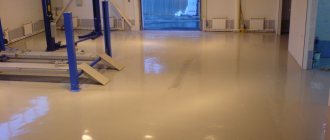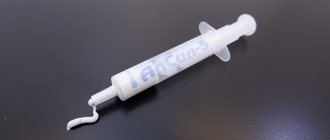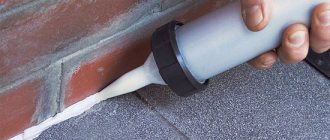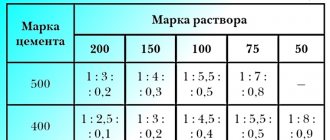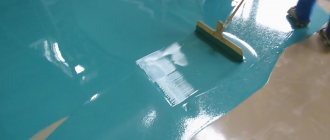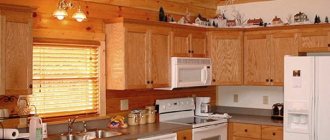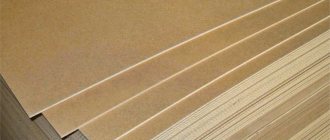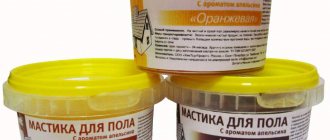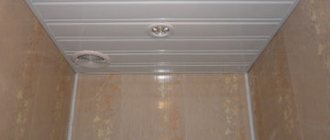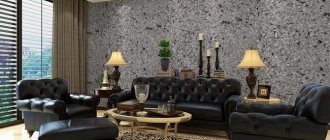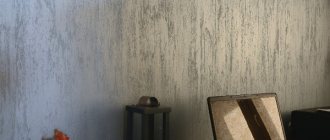Liquid self-leveling floors are increasingly found in various areas of our lives - in offices and gyms, apartments and houses, in production. And it’s not surprising, because they are famous for their high performance and attractiveness. And, depending on the scope of application and the desired result, a variety of coatings are used. For example, acrylic floors have proven themselves in manufacturing, but are beginning to be found in residential buildings.
Acrylic self-leveling floor
Acrylic floors
Features of cement-acrylic mixtures
The composition usually includes the following components:
- cement as a binder;
- acrylic, other polymer fillers;
- special fine sand;
- additional additives, usually mineral.
There are a large number of different options for fills, differing in composition, hardening conditions, suitability for various types of substrates, and decorativeness.
There are a large number of different fill options
Advantages and disadvantages
Cement-acrylic self-leveling floors have a lot of advantages and a couple of disadvantages. It is worth dwelling on these points in detail and noting the advantages:
- Waterproof. The hardened solution will not absorb moisture, so it is used for rooms with high humidity: wet workshops of industrial buildings and a bathroom in an apartment.
- Low cost, which allows everyone to equip with their own hands a flat surface for laying floor coverings.
- High strength to mechanical loads.
- Long service life up to 30 years, but subject to the filling technology.
- Easy installation. Handling self-leveling floors is not difficult even for inexperienced installers.
- Solid surface.
At first glance, it seems that filling can be done easily and simply, but in reality you will have to spend a lot of effort to ensure that the coating is of high quality. There is one drawback of a cement-acrylic self-leveling floor - due to low elasticity, the floor becomes covered with cracks, but this does not affect the durability.
Thanks to these qualities, cement-acrylic floors act as the main finishing leveler for the installation of floor coverings (parquet, laminate, linoleum, ceramic tiles, etc.).
Scope of application
Cement-acrylic floor in a dairy processing workshop
. Common in industrial premises that require frequent wet cleaning using aggressive detergents:
- Food warehouses.
- Seafood processing plants.
- Breweries.
Can it be used outdoors?
The frost-resistant structure allows it to be used for street parking.
This type of mixture is suitable for use in industrial buildings, but can also be used outdoors.
In addition to resistance to mechanical stress and chemicals, frost resistance is added. Therefore, they are used both outdoors and at low temperatures in freezers.
Application area
Cement-acrylic self-leveling floors can be installed in premises of any purpose. Most often, such coatings are installed on the following objects:
- production shops, workshops and laboratories;
- garages, covered parking lots and warehouses;
- shopping and entertainment centers;
- administrative buildings and social facilities;
- sports complexes and healthcare institutions.
Acrylic self-leveling flooring is often used for finishing residential premises. This coating is ideal for bathrooms and kitchens.
What mistakes are made when filling?
It is difficult to make a self-leveling floor from a cement-acrylic mixture. Therefore, the work must be carried out without errors that will affect the strength and other performance qualities.
Filling using technology
Here are the mistakes that occur when pouring cement-acrylic mixtures:
- Wet base. If the surface of the concrete base has a moisture content of more than 4-5%, bubbles will appear and adhesion will decrease.
- Dirty or small containers. If the container is dirty, the composition will not mix well. It will contain foreign components that form porosity. Ineffective stirring is possible with small container volumes.
- Mixer power. Use a drill at low speed with a power of at least 800 watts.
- Incorrect drill attachment. For effective stirring, a screw nozzle is required; the height of the nozzle should ensure stirring throughout the entire volume of the container.
- The presence of vibration when distributing the mixture. Vibrations interfere with the creation of an even layer, so use a squeegee that sets the required gap.
- Garbage. Any speck under the layer of mixture forms lumps.
If the filling technology is followed, the screed will be of high quality and will last for a sufficient period of time.
How to make a high-quality self-leveling floor with your own hands:
Special characteristics of cement-acrylic floors
The floor surface can be matte, which eliminates the risk of slipping, or maybe glossy for beauty. The mixture adheres to the base so firmly that under no circumstances does it peel off, even if cracks appear on the surface, which rarely happens. Their resistance to temperature changes is also high, which makes flooding possible on the street without a roof.
Properties of such floors:
- after hardening, the mixture becomes durable and resistant to many factors;
- service life – 30 years;
- as a result, ideal surface evenness is achieved;
- Any color and any design solution is available.
To lay a cement-acrylic floor, you need to prepare the base; for this, a regular special primer is used, which hardens very quickly, significantly speeding up the process. You should definitely hire a professional for this type of work. After applying the base mixture, everything is varnished on top to protect it from water and moisture.
5 reasons to choose acrylic self-leveling flooring
- The material repels moisture, so when creating a coating in open areas there will be no additional costs for waterproofing.
- Temperature changes and precipitation do not have a negative impact.
- The average service life of flooring is 30-35 years.
- There is a full palette of colors to choose from. Additionally, you can choose a matte or glossy texture.
- Due to the low consumption of materials for acrylic self-leveling flooring, the price is more than affordable.
Types of self-leveling floors and their characteristics
Before making the final decision to purchase a floor, you need to understand its features in detail, read general information and reviews.
Cement-acrylic floors
Cement-acrylic coating consists of a mixture of cement, quartz and various plasticizers based on acrylic. These floors are in greatest demand in the industrial sector. They can be found much less often in residential areas.
The main advantages of cement-acrylic floors:
- The cured coating does not allow moisture to pass through and is effective in places with high humidity, such as laundries or car washes.
- Floors can withstand severe mechanical loads.
- Compared to other types of self-leveling floors, the acrylic-cement version has a favorable price.
- To install such a floor, you do not need to have any special skills; any craftsman can do it on his own.
- Long service life. The warranty is over 30 years. Naturally, such strength is only possible if the cement-acrylic floor is properly poured.
- The appearance of small cracks does not affect the solidity of the structure.
There are also disadvantages that you should be aware of before purchasing coverage. First of all, this is the installation process, which is lengthy and has some difficulties. Also, the material is not elastic enough, which is why cracks may appear on the surface. Although they do not affect the durability of the floor, the appearance suffers because of them.
Reviews about poured cement-acrylic floors:
Elena: “I chose this option because of its affordable cost combined with durability. The thickness of the floor was 30 millimeters. A black and white drawing was used as decoration, and the new floor looks great, all the guests and relatives are delighted. Since the strength of this coating is its moisture resistance, we placed it in the bathroom. I hope it will last a long time."
Alexander: “I flooded the floor in my wife’s bedroom. At the moment I haven’t noticed any cracks, although my wife torments me with regular rearrangements. No complaints about the coverage. I plan to install it in my room too.”
Judging by customer reviews, they are attracted by the affordable price of floors made from a mixture of cement and acrylic, as well as its durability and moisture resistance.
Polyurethane floors
The coating consists of a polymer and has a number of advantages:
- Polyurethane gives the coating plasticity and elasticity; you do not have to level the floor before pouring.
- Polyurethane floors can withstand mechanical loads without dents or scratches.
- Polyurethane dries quickly, so you can begin installing furniture as soon as possible after installing the floor.
- If installation technology is followed, polyurethane coating can last more than 40 years.
- Due to the smooth surface, it is hygienic, dirt does not accumulate in it, and mold does not develop.
Types of self-leveling floor coverings
Polymer floors are made from various base components. The quality characteristics of the coating, their scope of application and classification depend on them:
- epoxy glossy, high-strength, wear-resistant coatings with water-repellent characteristics;
- polyurethane coatings, which in addition to strength are elastic, can withstand vibration and targeted impact;
- methyl methacrylate are characterized by the shortest possible polymerization time.
In addition to polymer compositions and depending on the presence of additional ingredients, experts identify several more varieties:
- acrylic durable coating, recommended for residential premises, as it can withstand low and medium loads and has a moisture-resistant surface;
- gypsum durable coating with a short hardening time, recommended for dry rooms, strongly absorbs moisture;
- rubber elastic coating with shock-absorbing properties, recommended for industrial premises with vibrating equipment and gyms;
- quartz, due to the addition of quartz sand, acquire anti-slip characteristics;
- concrete and cement floors.
Special mention should be made of floors with a 3D effect. This type, in addition to strength and moisture resistance, is highly decorative. Popular in restaurants and clubs. In residential areas they are often chosen for bathrooms. The choice of type of self-leveling floor depends on the operating conditions. To make the right decision, it is recommended to consult with specialists.
Polyurethane coatings
Self-leveling polyurethane floors are highly resistant to impact loads, acids and alkalis. They are durable, hygienic, and decorative, which allows them to be used in both industrial and residential areas.
Metal methacrylate floors
Methyl methacrylate coatings are high cost and difficult to install, which does not add to their popularity, but in certain situations this is the only type of self-leveling floor that can be used:
- in rooms with excessive loads on the base;
- at enterprises with a non-stop production cycle;
- under constant exposure to different temperatures (sudden changes).
Despite the large number of advantages, experts consider a significant disadvantage of the coating to be the strong unpleasant odor that lingers in the room during installation. After the surface hardens and the room is ventilated, it disappears.
Epoxy self-leveling floors
Coatings containing epoxy resin are characterized by high strength, wear resistance, and resistance to aggressive chemical environments. Epoxy self-leveling floors are environmentally friendly, have decorative appeal, but have one significant drawback - lack of elasticity. They are not recommended for use in rooms where there is a high probability of strong pinpoint impacts that can cause the coating to become unsafe.
Installation stages
The technology for pouring polymer coatings of different types is approximately the same. The manufacturer must indicate certain nuances on the packaging. Professionals who do pouring are well aware of all the intricacies of the process. The most important thing is careful preparation of the base (preferably concrete, but cement will also do) and strict adherence to technology. Any little details are important (they are usually ignored when filling on your own), as they affect the quality of the final result. Attention, if necessary, you can fill the floor with your own hands at home (by looking at photos and videos on this issue), without having sufficient experience, for free.
Work stage
The rough screed is poured in a thick layer
Among other things, the mixture for self-leveling floors should be distinguished according to the stage of work it carries out. For the main or black screed, levelers are used. These mixtures are poured over beacons with a large layer thickness.
Used to eliminate gross defects in ceilings and height differences. This type of fill dries quickly. You can save on volume by laying reinforcing mesh in a layer.
The top fill should be no more than 5 cm thick
The top leveling fill for decorative finishing is carried out with appropriate compounds in a thin layer of no more than 5 mm.
The mixtures are expensive and are used as final leveling.
The solution sets quickly, but final hardening comes with time.
Some types of mixtures are poured as a decorative coating, usually an epoxy fill for 3D floors.
It is important to understand that finishing mixtures can be applied to virtually any base, as indicated on the packaging. But when using a certain brand of self-leveling floor composition for a screed, you will have to use a finishing fill of the same brand.
How much does a quick-hardening self-leveling floor cost?
To calculate the approximate cost of a self-leveling polymer coating, you need to take into account not only the price of the service, but also the building materials. Another nuance is that different companies do not have a uniform approach to this criterion. You should focus on average indicators; they will not be overestimated. Too low prices raise doubts about the quality of the services provided.
The cost also depends on the availability of additional work:
- dismantling the old coating;
- leveling the floor covering;
- pouring a new screed and its type;
- waterproofing devices.
The cost of self-leveling epoxy and polyurethane flooring per square meter also varies. When pouring, the second one is cheaper than the first one (the mixture itself is more expensive than the second one). Taking into account all these points, you will get an average price, in reality it can be higher or lower, and much less.
Why is the cost different?
The difference in price is determined not only by quality, but also by the professionalism of the craftsmen. Companies that have been working in the market for several days and value their reputation do not provide services cheaply. But professionals work quickly, efficiently and guarantee their work. The Streamline company is one of these. A single master with little experience, who is just starting to pour polymer floors, will offer to do the work at the lowest price, but pouring will take a lot of time and no one will give a guarantee of quality.
The use of self-leveling floors in technical rooms
Each technical building has its own requirements and features. There are safety and sanitation standards in accordance with which design and construction are carried out. Depending on the required properties of the coating, you can decide which floor to choose and from what materials it should be made. To find out whether it is worth using self-leveling floors at home, watch this video:
- Methyl methacrylate self-leveling flooring is ideal for a warehouse. This coating is highly durable and can be used in technical rooms. This coating is not cheap and requires a flat surface before application. The drying speed is relatively high, so when carrying out work you should act as quickly as possible. You can also use types of floor coverings: cement, epoxy and polyurethane.
- In a car service center or garage, the use of polyurethane self-leveling floors is justified. Self-leveling or highly filled bases with a layer of more than 5 mm will help hide uneven subfloors and also protect the surface from harmful chemical compounds. An alternative is polyurethane-cement coatings.
- Acrylic-cement bases are well suited for outdoor use. Their physical properties allow them to withstand temperature changes well. These coatings have high frost resistance, sufficient strength, are not afraid of high temperatures and do not collapse under the influence of moisture.
In technical premises there are increased requirements for construction work. The self-leveling floor must meet the required parameters, so it is necessary to familiarize yourself in detail not only with the properties of the coating, but also with the chosen brand.
In this regard, you need to study the instructions for use and quality documents for the product.
What does the cost depend on?
The issue of price is one of the main ones in construction and repair work. The materials used for laying self-leveling mixtures are not cheap, but significant savings are provided by the conditions for carrying out the work - the ability to do it yourself, and the speed of drying the layer. The cost of such a floor largely depends on the chosen composition and layer thickness - a properly carried out preparatory stage will also help save money. The price is necessarily increased by special properties - for example, greater transparency, unusual coloring, antistatic or anti-slip effect.
The issue of price is one of the main ones in construction and repair work.
Acrylic paints
How to install heated floors Review of methods for installing heated floors
Acrylic paint for concrete floors is a coloring composite based on acrylates and polyacrylates with the addition of various additional components that serve to form a protective film. The esters in the composition ensure that the material is resistant to water and dries quickly.
Thanks to additives, acrylic paint can have a different appearance: glossy, matte or semi-matte. The membrane formed by additive polymers ensures the resistance of painted concrete to mechanical stress and the influence of chemicals. In addition, they reduce the rate of destruction and dusting of the top layer of the concrete floor, significantly increasing its service life.
Thus, acrylic paint has the following advantages:
- increased resistance to moisture;
- environmental Safety;
- resistance to high temperatures, which allows the use of this type of coating in almost any operating conditions;
- ease of application and high drying speed, thanks to which the painted floor is ready for use within a couple of days;
- increasing the strength and durability of the concrete floor.
The dye is applied to the degreased surface with rollers or brushes; Industrial sprayers can also be used over large areas. Applying one layer is sufficient, but for better performance, two layers can be applied.
What does consumption depend on?
When calculating consumption, it is necessary to take into account the area of the room, density, consistency of the solution, and planned thickness. To reduce consumption, it is necessary to level the base as thoroughly as possible. The degree of surface evenness and the corresponding calculation of the layer thickness are carried out using laser level measurements.
To reduce consumption, it is necessary to level the base as thoroughly as possible.
New technology, wide range
Having decided to use self-leveling floor technology at home, many are faced with the obvious problem of choice. Many questions arise, for example: which brand of self-leveling floor is better or which self-leveling floor is better, gypsum or cement. There are many types of self-leveling floors and not everyone understands them.
Let's first consider what types of self-leveling floors are produced, which ones are best to choose for a given situation.
Cement-acrylic self-leveling floor is the cheapest of all options
Cement-acrylic self-leveling flooring is the cheapest of all options. It perfectly withstands the influence of water of different temperatures, while remaining non-slippery. Therefore, floors made from this material are often used in swimming pools and in rooms where large amounts of water often fall on the floor, such as car washes. For apartment renovations, this type of coating is ideal as a bathroom coating.
Polyurethane self-leveling floors are characterized by increased wear resistance, they are difficult to deform and generally leave any damage on them. Therefore, they are most often used in industrial premises, parking lots and warehouses, but they are also suitable for apartments. Functional and unpretentious option.
Epoxy floors are resistant to physical and chemical attack
Epoxy - resistant to physical influences, as well as chemical ones. Acidic and alkaline solutions are not dangerous for them, therefore they are often used in medical institutions and pharmaceutical plants. But they are distinguished by excessive fragility. Very safe. They have a perfectly flat surface that is easy to care for due to their solidity and antistatic properties.
Methyl methacrylate floors are quick-drying, but are rarely used due to the complexity of the manufacturing technology. It has a specific smell, which requires initially good ventilation of the room.
Depending on the type of coating, there are matte, semi-matte, glossy, semi-gloss self-leveling floors, as well as multi-color floors made with a regular or three-dimensional image. The latter are an excellent option for people who want to do something original. In addition to just the image, the decoration of such floors uses additional lighting or luminous paint.
Methyl methacrylate floors are quick-drying, but are rarely used due to the complexity of the manufacturing technology
Now let's move directly to the features of the choice, to which self-leveling floor is better.
Possible mistakes
Proper installation requires careful attention to all work carried out. Certain points to take into account:
- too high humidity of the base surface;
- increased content of dust and dirt;
- poorly carried out degreasing of the surface;
- fragility of the base surface, presence of cracks;
- poorly mixed filling solution;
- non-compliance with technology, violation of the sequence and timing of laying layers.
Poor preparation of the base and violation of installation technology can lead to cracking of the self-leveling floor.
To avoid problems in the future, it is worth carrying out the work correctly
Types of mixtures for screed
Depending on the room in which the work is planned, as well as what result is needed, different compositions are recommended for use.
Mixtures for self-leveling floors for finishing and rough filling differ in the thickness of the possible layer, drying time, strength and, of course, price.
It is customary to distinguish between types of mixtures using the following criteria:
- fill layer thickness;
- type of diluent: aqueous or solvent;
- electrical conductivity coefficient;
- layer texture;
- base binder.
Most of the basic properties of the mixture for self-leveling floors depend on the main binder
| Basic component | Scope of application | pros | Minuses |
| Gypsum | Rooms with low humidity (up to 70%) | The thickness of the leveling layer can reach 10 cm, which makes it possible to hide very significant differences in height at the base; Low thermal conductivity; Budget cost. | The readiness period and drying period are longer than that of cement mortar; They lose strength at high humidity. |
| Cement | No limits | Fast coating ready time; Not susceptible to high humidity; High strength. | High price; Thin layer filling up to 5cm. |
| Epoxy resin or methyl methacrylate | Without restrictions, most often for non-residential premises. | Daily availability of coating; Excellent design and decorative capabilities; Can be applied over 3D layouts; Increased wear resistance. | Not suitable for leveling significant surface defects; Toxic when working; High solution consumption: more than 1.5 kg per 1 m2. |
| Polyurethane (polyaspartates) | Most often used in private construction. | High strength; non-slip, abrasion-resistant; Suitable for filling inclined surfaces without the formation of sagging. | Not resistant to mechanical damage; Long readiness cycle; High price |
Advantages and price of cement-acrylic surfaces
Cement-acrylic self-leveling surfaces combine all the advantages of polyurethane and epoxy coatings. They are characterized by the following advantages:
- has tightness and resistance to moisture;
- large selection of colors;
- considered universal, used in various rooms;
- has elasticity and fire safety;
- resistant to external factors and abrasion;
- non-toxic.
Even if the cement base cracks over time, the upper part of the floor will remain unchanged. Cement-acrylic self-leveling floors dry quite quickly after pouring. The only disadvantages include: it is not possible to carry out partial repairs, and there are also compositions that have a high cost and require complicated preparation of the floor surface.
The price of cement-acrylic materials depends on the preferences of the buyer. For example, transparency of the floor, color scheme, anti-slip. Although the price of such mixtures is not small, it pays off in the fact that you can fill the floor yourself, observing the main rules of use. The price of cement-acrylic materials varies depending on the composition, the material chosen and the thickness of the layer that is required.
Cement-acrylic self-leveling floor (cost of work per m2)
| Name | Price per sq. meter |
| Cement-acrylic self-leveling floor | from 600 rub/m2 |
| Cement-acrylic self-leveling floor for car service | from 600 rub/m2 |
| Cement-acrylic self-leveling floor for garage | from 600 rub/m2 |
| Methyl methacrylate self-leveling floor | from 1100 rub/m2 |
| Floor screed repair | from 600 rub/m2 |
| Dismantling the floor screed | from 300 rub/m2 |
*Estimated prices may vary. The price depends on the area, distance of the object and working conditions. To find out how much it costs to install a self-leveling floor in your case, please call: +7(499)350-24-10
Turnkey cement-acrylic self-leveling floor: price per m2
| Name | Price per sq. meter |
| Cement-acrylic self-leveling floor | from 600 rub/m2 |
| Cement-acrylic self-leveling floor for car service | from 600 rub/m2 |
| Cement-acrylic self-leveling floor for garage | from 600 rub/m2 |
| Methyl methacrylate self-leveling floor | from 2500 rub/m2 |
*Estimated prices may vary. The price depends on the area, distance of the object and working conditions.
The use of self-leveling floors in domestic premises
For apartments and houses, the selected floor must be suitable not only for technical, but also aesthetic parameters. In addition to physical characteristics, it must have an attractive appearance, a smooth and safe surface. For the secrets of installing self-leveling floors, watch this video:
- For apartments and houses, compositions based on epoxy resins are used. For rough surfaces that will later be finished with finishing materials, floors based on gypsum and cement bonds are used.
- In bathrooms, as noted above, a cement-based subfloor can be made under the tiles.
In addition to epoxy, other types of polymer self-leveling floors can be used as independent coatings that do not require finishing. For beauty, dye is added to the self-leveling floors or a 3-D image is laid down . The only condition is that they comply with environmental safety standards. Polymer bases are resistant to moisture and will last a long time. By adding dye, they can be given the desired color. - For the kitchen, dining room or living room, various acrylic pigments are added to epoxy self-leveling floors for beauty, and a backing with a pattern is placed on the canvas. Thus, interesting coatings with the so-called 3D effect are created. Such solutions can be implemented not only on large floors, but also in narrow corridors, toilets and bathrooms.
Whatever flooring you choose for your home, it is important that it is installed by professionals. The materials are unique, as are the technologies for laying them. An unprepared person may simply not have enough time to install a self-leveling floor and the work will be ruined.
The material will gain minimal strength, and it will not be possible to correct errors without extra costs. The selection of construction specialists is no less important than the choice of the best coating.
Self-leveling floors are a modern finishing material that can decorate any room. Their installation requires proper preparation and installation in accordance with building codes and manufacturer's requirements. They have a long service life and, with high-quality installation and operation, can last for decades.
> Methyl methacrylate floors
Choice of coverage
When choosing, what matters is the area where the floor covering will be applied, the conditions, the timing of the work - for example, methyl methacrylate solutions have a very short hardening period, so they can be put into operation in just two days, polyurethane solutions can withstand high dynamic loads well, and the peculiarity of cement-acrylic self-leveling floors – their ability to effectively level even the most difficult areas. It is the latter option that is most suitable for residential premises due to its safety and aesthetic appearance.
The self-leveling floor can level even the most difficult areas
Selection factors
When choosing one or another type of self-leveling floor for a specific room, it is necessary first of all to take into account factors such as the purpose of the room and its technical characteristics, as well as the type and condition of the base, the level of mechanical loads, chemical and temperature influences.
To choose the right type of self-leveling floor, you should answer a number of questions. These answers will determine the best coverage option.
- What is the purpose of the room?
- What condition is the base in and what is it made of?
- Does the future floor need decoration?
- What mechanical load is expected on the floor?
- Is there a possibility of the coating being exposed to chemicals?
- Are there any special requirements for the floor, such as anti-slip, antistatic properties, and so on?
In any case, it is advisable to try applying a small sample of the material to the base to see how it behaves on this coating.
Installation features
The installation of an acrylic coating in a room can be divided into two stages - preparing the base and pouring the self-leveling floor. Let's look at them in detail.
Preparing the base
Installation of a cement-acrylic self-leveling floor begins with preparing the concrete base. The screed is allowed to dry, after which the surface is leveled, degreased, and dust is removed using industrial vacuum cleaners. If oil has become embedded in the coating, such areas are cut out, then filled with fresh concrete, dried and leveled. If defects are found on a large area of the base, it is more advisable to make a new screed.
Permissible moisture content of concrete is no more than 4%; roughness sizes - up to 2×2 mm.
The prepared concrete base is coated with a layer of special primer. It will seal microcracks and roughness on the surface, ensuring a strong connection between the base and the acrylic coating. The primer is applied to the surface with a roller or spray. The material dries in 3–5 hours.
If the primer turns white or bubbles, it means the humidity in the room is high. In this case, you will have to dry the room and then continue work.
If there are cracks and chips, the concrete base is puttied with special compounds. To prevent height differences from forming on the surface, mineral fillers are used - quartz sand of a fraction of 0.4 mm. After the putty has dried, another layer of primer is applied to the base. The result is a smooth and slightly rough surface on which you can install a cement-acrylic self-leveling floor.
Pouring self-leveling floor
The pouring of the acrylic self-leveling floor begins one day after preparing the base. The mixture is diluted in a large container, observing the proportions of components recommended by the manufacturer. The finished solution should resemble jelly in consistency. The presence of lumps and bubbles is unacceptable.
Within half an hour, the polymer mixture must be distributed over the base, otherwise it will begin to harden, losing its properties. The liquid solution is poured onto the surface in strips and then leveled using a squeegee. The recommended coating thickness is up to 1 cm. 10 minutes after pouring, you need to go over the solution with a needle roller to remove air bubbles, otherwise the coating will quickly crack and begin to peel off.
Acrylic self-leveling floors are installed at temperatures from +5 to +25° Celsius. At low temperatures, the mixture is poorly distributed over the surface, and at elevated temperatures it hardens too quickly.
It is advisable to distribute the polymer composition immediately over the entire area of the room. If this cannot be done, then the strips of acrylic self-leveling floor will have to be joined 30–40 minutes after pouring the previous batch. Moving on fresh surfaces is only permitted in special shoes - flat-footed shoes.
An acrylic self-leveling floor will gain minimum strength in 24–48 hours and will be able to withstand foot traffic. After 3–4 days, the coating will be ready for full use.
Order acrylic floor installation
The best universal self-leveling floors
Thanks to universal mixtures, you can quickly and relatively easily level subfloors with many imperfections. The liquid solution fills all roughness, is evenly distributed and dries quickly, forming a smooth surface.
5 GLIMS S-Line
Possibility of use without beacons Country: Russia Average price: 279 rub. Rating (2020): 4.6
A fast-hardening, non-shrinking, self-leveling self-leveling floor independently forms a perfectly flat horizontal surface, even when working without beacons. Its additional beauty is that, despite its universal composition, it is not necessary to use finishing mixtures after it. The material can be applied to cement and gypsum screeds, concrete. The diluted mixture is very easy to work with and does not require any special professional skills from users.
Judging by the reviews, users consider the self-leveling floor from GLIMS to be the best for those who do not have the skills to perform screeding. The reason is that it is very easy to work with, it is not necessary to use beacons. In any case, the surface is smooth. The self-leveling floor hardens quickly, and after four hours, if absolutely necessary, you can already walk on it.
4 Dauer Ecoline
Rough type gypsum leveler Country: Russia Average price: 230 rub. Rating (2020): 4.7
The difference between this self-leveling floor is that it can be used with equal success for interior and exterior work. Withstands increased loads, performs well in public spaces, and is not afraid of moderate humidity. The Dauer self-leveling mixture dries quickly (you can walk after 3 hours), is highly frost-resistant, and contains reinforcing fiber, which minimizes the likelihood of cracking.
All characteristics declared by the manufacturer are fully confirmed by positive user reviews. They really like the self-leveling floor and other mixtures of the domestic brand. What is especially attractive is their wide range of uses - coarse gypsum levelers are suitable for outdoor work, unlike most other self-leveling floors.
3 Ceresit CN 175
The best self-leveling floor for weak foundations Country: Russia Average price: 450 rub. Rating (2020): 4.8
Quite expensive compared to self-leveling floors from other companies, but a very high-quality mixture designed for leveling the floor before laying various coatings, repairing defects, and making screeds. Suitable only for dry rooms with moderate load levels. The peculiarity of the mixture is the absence of shrinkage, the possibility of use on weak bases, resistance to cracking, environmental friendliness and compatibility with heated floors.
In reviews, many ordinary users and professional builders write that this is one of the best self-leveling floors they have ever worked with. They especially like that the mixture gives an almost mirror-like surface. Overall, they recommend this brand of mixture as an excellent leveler, suitable for working with weak substrates.
2 Weber 4100
Fastest drying Country: Russia Average price: 633 rub. Rating (2020): 4.9
Self-leveling self-leveling flooring from Weber is characterized by a very high hardening speed. Foot traffic on it is permissible within 3-4 hours after pouring. The high strength of the composition allows it to be used in areas with high traffic. Thanks to the mixture, you can get a perfectly smooth screed without the need for subsequent sanding or finishing pouring, even under thin floor coverings.
Users recommend self-leveling floors from this brand and call them one of the best. Due to its excellent spreadability, no special professional skills are required to work with the mixture. They also like that the compound dries quickly, so repairs don't take very long. An additional advantage is compatibility with underfloor heating systems.
1 Founded by Skorline FK45 R
The thinnest layer Country: Russia Average price: 290 rub. Rating (2020): 5.0
One of the best companies of self-leveling self-leveling floors. Osnovit Skorline can be used when renovating apartments and offices, as a base leveling coating for laminate, carpet, linoleum, tiles, parquet boards. It is allowed to apply a layer from 2 to 100 mm, depending on the thickness, the drying time is from 1 to 28 hours. Suitable for interior use only, compatible with underfloor heating systems.
The advantages of the mixture include simplicity and ease of use, fiber reinforcement, high spreadability, providing a perfectly flat surface. In reviews, users often point out the low cost, the ability to apply the finished mixture in a very thin layer, and recommend other products of this brand.
All about methyl methacrylate coatings
Among modern floor coverings, seamless ones formed from liquid mixtures are quite popular. They are applied to the prepared floor using the pouring method. The mixture is carefully leveled and bubbles are removed. After hardening, it forms a durable, wear-resistant coating that can withstand significant mechanical loads.
There are several types of self-leveling floors, determined by the type of base material:
- polyurethane;
- epoxy;
- methyl methacrylate;
- concrete.
Methyl methacrylate floor coverings occupy a special place among seamless floor coverings. They are called mixtures consisting of acrylic and methacrylic resins.
A little materiel
Methyl methacrylate is not a new substance. It was created under the Plexiglas brand back in 1928, and its industrial production began at the Röhm and Haas Company in Darmstadt (Germany). In the USSR, the material was synthesized in 1936. Everyone knew it under the names plexiglass, plexiglass and plex (colloquially).
Its most common type in those days was transparent sheets several mm thick. It was placed on a desk, used as transparent partitions, used to make portholes, in modeling, and in dozens of other areas. Such sheets were easily scratched and melted under high temperatures.
This material is still widely used today. The greatest application is in the manufacture of various parts for industrial production. Thus, methyl methacrylate is also used in the manufacture of self-leveling floors. When polymerized, the methyl methacrylate monomer turns into polymethyl methacrylate. This name is more correct for a flooring substance obtained from a methyl methacrylate liquid mixture.
Over many years of improving the material, methyl methacrylate has acquired new properties and got rid of its inherent disadvantages. However, even today it is the lowest temperature (in terms of the upper temperature threshold of operation) material of all self-leveling polymer floors (MMA, polyurethane, epoxy).
Methyl methacrylate is a methyl ester of methacrylic acid. Its density approaches unity (0.936 g/cm³), boiling point +101 ºС.
Types of coatings based on methyl methacrylate
Methyl methacrylate materials are also known as MMA. In addition to the main self-leveling floor coverings, they are used to make:
- primers for asphalt, concrete, metal;
- putties for cracks;
- elastic compounds for expansion joints;
- concrete impregnation;
- waterproofing liquid materials;
- liquid mixtures for dust removal and concrete strengthening;
- elastic compounds for freezers and street coverings;
- special coatings for wet rooms;
- quick-curing polymer concrete.
Based on the thickness of MMA coatings, they are divided into:
- thin-layer coatings (paints);
- self-leveling polymer floors;
- highly filled systems with different types of sands.
The most well-known MMA coatings are the product lines of ICT and DURACON. These floors are supplied to the market in the form of sets of a primer solution, a colorless binder composition of mixtures of esters, filler sand of various shades and varnish for the top layer.
In order for the MMA coating to be reliable, manufacturers require that it be applied to durable concrete bases with a thickness of at least 70 mm. In such a combination, MMA protection, which is stronger than concrete, will be the most durable.
Application
Floors based on methyl methacrylate compounds are used in both industrial and civil construction. In polymerized form, they are absolutely inert and highly resistant to chemicals, mechanical stress, and temperature changes.
They are used:
- in the production of food and pharmaceutical companies;
- in medical centers;
- in laboratories;
- in company offices;
- in warehouses;
- in exhibition halls;
- at sports facilities;
Specifications
- thickness of methyl methacrylate floors - from 0.5 to 16 mm;
- temperature of application and operation of most compositions is from -26 to +35 ºС;
- curing time - from 1 to 2 hours;
- compressive strength - 40 N/mm²;
- completely waterproof.
Advantages of methyl methacrylate floors
- The main advantage of the coatings described is rapid curing - within 1-2 hours. This property allows, in emergency cases, to produce coatings without stopping the functioning of the objects being repaired - all work and polymerization of materials are completed before the start of the morning shift.
- These floors have high strength and hardness, resist the scratching effects of wheel spikes, and therefore are used in garages and parking lots.
- Methyl methacrylate floors tolerate low temperatures well, so their installation and operation are possible not only in freezers, but also outdoors. At sub-zero temperatures, floors can be laid.
- These coatings are not destroyed by ultraviolet radiation - they do not fade or turn yellow in the sun.
- They are completely waterproof.
- Thanks to special dyes or sands of various colors, manufacturers achieve a wide range of product shades. Today, coatings are produced in several dozen types of tones. The floors are also diversified by decorative particles scattered over the coating before laying the finishing layer.
- UV resistance.
- Good maintainability. Individual floor defects can be quickly corrected by local treatment and spot application of the mixture.
- An aggressive microenvironment in the form of fungi and bacteria does not form on methyl methacrylate.
- Aesthetically attractive appearance.
- The service life determined by manufacturers is 25-40 years.
Flaws
- Work on the production of MMA floors involves toxic materials that require personal protective equipment - respirators. During the application process and subsequent polymerization of the layers, active supply and exhaust ventilation is required.
- Due to rapid polymerization, it is difficult to obtain a perfectly even coating, so it is necessary to involve specialists with good skills in pouring such floors.
- MMA coatings are quite expensive compared to other analogues of seamless polymer floors (polyurethane and epoxy). In addition, the presence of a large number of ingredients complicates the processes of preparing working mixtures, so the labor for making these floors is also expensive. Property owners choose MMA floors when the loss from the non-functioning of the facility exceeds the difference in prices between “fast” and regular flooring.
Preparatory work
Concrete floors are thoroughly dried (if necessary) to a moisture content of no more than 4% and treated with grinding machines to reduce unevenness. In places inaccessible to machines, sand by hand. Then the surface is cleaned with industrial vacuum cleaners.
Tools
For coating application:
- buckets, measuring containers and glasses;
- mixing containers;
- stirring attachments for low-speed drills;
- squeegees and rollers for leveling mixtures;
- needle rollers to remove bubbles;
- shoes with needle soles.
Basic floor installation process
All components of MMA floors are produced by manufacturers in the form of dry mixtures (sand with fillers) and liquids - mixtures of resins and hardeners (catalysts). At the site, workers mix the materials in proportions according to instructions and immediately apply them to the floors using hand tools.
List of operations performed on the prepared floor:
- roller primer;
- manual application of sand to enhance adhesive properties;
- putty with a wide squeegee on the entire surface “to tear off”;
- applying the main filling layer - leveling is done with a squeegee;
- treatment with a needle deaeration roller to eliminate air bubbles;
- applying polymer chips (if necessary);
- applying a finishing layer of varnish.
Sand is applied over a fresh primer layer to increase the adhesion of the main filling layer. After the primer has polymerized, excess (non-adherent) sand is swept away and reused. Multi-colored polymer chips and other decorative elements (sparkles, flocks) are applied to decorate the floor and make it look elegant.
Instead of output
The value of methyl methacrylate coatings lies in the unsurpassed speed of manufacturing wear-resistant floors, as well as the ability to install them in subzero temperatures. This also explains their popularity. MMA floors are ready for use 2 hours after application. For similar polymer floors (polyurethane and epoxy), such readiness occurs after 7 days.
The best finishing self-leveling floors
Finish self-leveling floors are a polymer mixture that, when hardened, forms a perfectly smooth surface covering. That is, first universal mixtures are used to level the surface, and on top of them a finishing self-leveling floor is used.
5 Sikafloor 264
The best option for a garage Country: Russia Average price: 31,762 rubles. Rating (2020): 4.6
These self-leveling floors are considered one of the best for garages and other utility rooms, but some buyers purchase them for the home. Unlike mixtures from many other companies, it is possible to choose a shade from a wide range of colors. Since the composition is made on the basis of epoxy resin, it does not have any unpleasant odor, and after drying it acquires a pleasant glossy shine. The cost may seem high, but the price is for a 30 kg container, which is enough for a fairly large area.
Calculation of self-leveling floor consumption per square meter
In order to correctly calculate the consumption of self-leveling floor, you need to know the following parameters:
S is the area of the room where the floor is laid;
H —thickness of the self-leveling floor layer;
P is the density of the self-leveling floor mixture.
The first two parameters are easily measured with a tape measure. The density of the mixture is indicated by the manufacturer on the packaging. After measuring the room and choosing the type of mixture, you can begin the calculation.
Formula for calculating consumption in kilograms for a room with a flat base:
Flow = S x H x P
If we divide the consumption in kilograms by the weight of the package, we get the number of bags required for installing the floor.
Example 1 . In a room with an area of 20 m2, a self-leveling floor 10 mm thick is laid. The density of the mixture is 1.5 kg/m2/mm. The mixture is supplied in 20 kg bags.
Consumption = 20 x 10 x 1.5 = 300 kg or 15 bags.
If the base of the room has a slope (a common occurrence for panel houses), then the flow rate must be calculated using the formula:
Flow = (S x H + (S xh) / 2) x P
, where h is the difference in height of the base.
Example 2 . In a room with an area of 30 m2, the difference in height of the base is 15 mm. A self-leveling floor 20 mm thick is laid. The density of the mixture is 1.6 kg/m2/mm. The mixture is supplied in 20 kg bags.
Consumption = (30 x 20 + (30 x 15) / 2) x 1.6 = 1320 kg or 66 bags.
Method of pouring cement-acrylic self-leveling surfaces
If you fill the floor yourself, follow the pouring rules, thanks to which you will get a perfectly smooth and beautiful floor. They are as follows:
- Prepare the base of the floor by clearing it of accumulated dust and dirt.
- Calculate the thickness of the applied layer, taking into account the unevenness of the floor.
- Prime the surface. The primer increases the adhesion of the base to the floor.
- Dry the primer layer and prepare a solution.
- Pour the prepared mixture, distributing it evenly with the necessary tool.
After all the work done, when the floor is dry, you need to apply a finishing layer (varnish). You should avoid common mistakes when pouring this floor, such as: a poorly cleaned, degreased surface; using a contaminated cooking container; Maintain base humidity - about 5%; Mix the solution with a special mixer with a screw attachment.
Types and characteristics of compositions
As already mentioned, liquid flooring is divided into two types: polyurethane and epoxy mixtures. Each of them has its own characteristics, which must be taken into account when pouring:
- Polyurethane floors are ideal in rooms where vibration prevails and large objects can fall. A liquid floor made from this mixture is not subject to deformation. He is susceptible to strong blows. He is not afraid of high and low temperatures. This type of coating can withstand the negative impact typical of warehouses and even production workshops.
- As for liquid flooring made from an epoxy mixture, everything is different. This type of fill is sensitive to pinpoint impacts or vibration. But its advantage is that it is not exposed to chemicals. Whatever spills onto its surface cannot leave an imprint. Epoxy flooring is immune to the negative effects of alkalis, acids and salts. Even gasoline cannot spoil the appearance of this type of coating. These floors are ideal for areas intended for laboratory research, food and pharmaceutical industries, as well as entertainment venues.
Design and stylistic ideas
Choosing a poured floor design is a difficult task. The main thing in this matter is harmony. The floor should be combined with the decor of the living room, hallway, kitchen, nursery, and other functional rooms. You can use almost any image to create a 3D effect. A lot depends on it; a picture can not only lift your spirits, inspire, calm, excite, but also cause aggression, poor health, and depression.
It is also worth considering the fact that the coating belongs to the category of expensive and durable materials; the pattern cannot be changed over time. When arranging the flooring, you don’t need to pay attention to fashion trends, which quickly become outdated, because you will have to admire the floor for more than one year, and perhaps not even a decade. Experienced designers recommend using classic motifs, for example, natural and seascapes.
When choosing the most suitable image, first of all you should pay attention to the purpose of the room, its style, which also affects the color palette. In order for all family members to feel comfortable, it is necessary to take into account everyone’s opinion and come to a common decision. Only in this case will it be possible to create a presentable and cozy interior. For clarity, let's consider several possible ideas using the example of different rooms.
For the hallway and corridor
The hallway is the calling card of any home. Its furnishings form the first impression of the owners, their tastes, preferences, and well-being. Among the features of the room one can highlight high traffic. Here the floor is constantly dirty and subject to abrasive influences, so it must be washed and cleaned frequently. Due to their characteristics, bulk structures are most suitable for existing conditions.
You should not use complex designs or three-dimensional landscapes in the corridor. One image in the center of the room is enough. It can be an abstraction, an animal, a plant on a plain background. You can also use imitation of masonry, tree cuts, and laid stones. It is necessary to abandon pictures with a cliff, an abyss into which you find yourself when you enter the front door. They will not bring vivid impressions for long.
For kitchen
Self-leveling flooring can easily be called the best solution for the kitchen. It does not absorb dirt, it is not afraid of stains from fat, spilled juice or wine, or other products that have fallen on the surface. He is not afraid of water and fire. Objects falling on the canvas will not cause any damage to it. In addition, kitchen spaces in most houses are small in size, so organizing the covering will require less money compared to a living room or bedroom.
You can choose almost any topic, but you must take into account the fact that the image should not discourage your appetite, but also not cause an excessive desire to eat. Floral motifs, fresh grass with drops of dew, and sea surf will look great here. You can also use an urban direction, for example, landscapes of megacities. A room where the floor and apron are designed in the same style looks especially impressive.
For the living room
The living room is intended for active recreation, all family members gather in it, and guests are invited here. It is appropriate to use accents in this room. Here you can fully implement interesting design solutions that are inappropriate for other rooms. For example, create an abstract composition, set an image of an evening or night city, various picturesque landscapes, even paintings with seething volcanoes.
Using drawings, you can also create zoning in the room, for example, using a marine motif, divide the room into two functional parts, one of which will be on the shore, the other in the middle of the sea. An excellent solution would be bright colors that tone and invigorate the body. These shades include red and orange.
For the bedroom
The bedroom is a place to relax. Here you should use calm textures and relaxing motifs to create a romantic atmosphere. Various flowers, small waterfalls, insects, dew, and grass would look appropriate. The plots moving from the floor to the walls look interesting. For a married couple, you can choose an image of swans swimming together on the lake.
Self-leveling floors should complement the interior of this room, and not act as the main accent. When decorating, preference should be given to pastel colors, or natural ones: blue, green, yellow, brown. They do not evoke strong emotions and symbolize purification and peace. Bright, saturated colors, especially red, attract attention and do not allow you to relax.
For children's
In a children's room, you want to bring to life the most original ideas, to create a real fairy tale for your baby. Floors with 3D effect allow you to achieve your goals. When choosing a picture, parents often choose images of characters from cartoon series. But the child grows quickly, as he grows up his idols change, and existing pictures cease to satisfy him.
You should choose a suitable design taking into account the child’s gender. For boys, images of castle ruins, space, cars will be relevant, for girls - flowers, plants, favorite heroines from fairy tales. Pictures with animals will suit all kids, regardless of their gender. The main thing is not to overuse with an abundance of complex patterns, so as not to overload the room.
For bathroom and toilet
The self-leveling floor creates good waterproofing. It does not absorb or allow moisture to pass through, making it an excellent solution for the bathroom. The most common motif for this room is a marine theme. Fishes swimming in the water, friendly dolphins, the coast, and lagoons are often depicted here. These paintings allow you to relax as much as possible and make your time enjoyable.
Instead of ordinary images, you can use real pebbles or shells covered with a protective layer in the toilet. It is not necessary to use the water world with its inhabitants, as well as landscapes associated with the ocean, everywhere. The space theme is also popular here: a view of the Earth from orbit, planets and their satellites. Less common, but also in demand, are drawings of exotic animals, flowers, and trees.
Features of self-leveling 3D floors
In terms of manufacturing technology, 3D floors are practically no different from their self-leveling counterparts, which were previously used exclusively in industrial and public spaces. The main highlight is the effect of presence. Three-dimensional drawings have long been included in many areas of our lives. You will no longer surprise anyone with such things as photo wallpapers, stretch ceilings with a realistic image of the starry sky.
Self-leveling 3D floors appeared not so long ago. The idea for their creation originated from street art. Three-dimensional graphic pictures were drawn by street artists; their creations aroused interest and admiration among the audience. Creative designers picked up this idea and brought street technology into living spaces. Many people also liked this, as evidenced by the interest in flooring.
The drawings can be absolutely anything: your own photos from a digital camera; ready-made pictures downloaded from the network; paintings made to order. The main thing is high quality, large size images that can be transferred to the base using a large-format plotter in any advertising agency. However, finding a device of the appropriate size is quite difficult, so in most cases the picture is divided into several fragments.
The image is printed either on banner fabric or on a satin base. You can also use ready-made vinyl films or photo wallpaper. You can also create a 3D effect using various objects placed on a base polymer layer. For example, multi-colored sand, shells, pebbles, wood slices, coins, etc. When choosing this method, it is worth taking into account the high consumption of materials and the increased cost of coating.
When choosing a design, you must not only rely on personal preferences and the functionality of the room, but also take into account the psychological message. Too aggressive paintings with a terrible plot can have a negative impact on the psyche and health.
Combination of self-leveling 3D floor with heating system
It is necessary to decide on the heating system before installing the self-leveling floor. The reliability, quality and service life of the floor itself will depend on the correct choice of option. Filling is possible on the following systems:
- Electric. Thin heating electrodes reduce the consumption of polyurethane mixture, as well as repair costs in case of breakdown.
- Infrared. Film elements have much greater performance and are characterized by high heat transfer.
- Water. The classic heating method involves laying water pipes. Negative points include high mixture consumption and maximum floor thickness.
Acrylic cement floors
Liquid self-leveling floors are increasingly found in different areas of our lives - in offices and gyms, apartments and houses, in production. And it is logical, because they are famous for their highest performance and attractiveness. And, depending on the scope of implementation and the desired result, a variety of coatings are used. For example, acrylic floors have proven themselves in production, but are beginning to be found in residential buildings.
Acrylic self-leveling floor
Acrylic floors
The content of the article
Self-leveling floor - what is it?
A self-leveling floor is a typical type of screed, which is created using a special technology using self-leveling consistencies. This composition contains binder components (usually the highest quality cement), fractionated sand, various additives prepared on the basis of polymers, as well as mineral fillers.
Installation of self-leveling floors
On a note! The self-leveling floor has become famous, first of all, for the fact that it is extremely narrow. When pouring such a coating, you don’t have to worry that the floor level will be very high and take up a fair amount of free space. On average, the thickness of the self-leveling coating is about 3.5 mm.
Decorative self-leveling floor
Self-leveling flooring did not get its name by chance. It is literally poured onto the prepared rough surface, leveled on it and dried perfectly. In this way, the result is a completely even, smooth, strong coating. Visually, the finished layer resembles linoleum, and to the touch it resembles tiles, except that it does not have seams and joints. It is interesting that thanks to such a floor in a house, it is possible to immediately create a uniform and completely level coating in all rooms without thresholds, joints and cracks.
Acrylic self-leveling floor
The self-leveling floor can serve as the basis for a final coating or be one itself - it all depends on the type of consistency used, the purpose of the room and the wishes of the owner. Due to the fact that the solution is perfectly and moderately distributed over the surface of the rough screed, you can get a completely even coating, on which materials that require evenness of the base are later laid - these are tiles, laminate, parquet and other floor finishing options.
Self-leveling floors are also often used when it is necessary to install a heated floor system. Using a watery floor as a finishing coat in this case, you don’t have to worry about it being affected by the temperature.
Pouring acrylic self-leveling floor
The strength and resistance to water of such a floor is ensured by cement, which acts as a binder. The material adheres well to the base and ensures that the coating does not allow excess water coming from inside or outside the room to pass through.
Pouring an acrylic floor
Types of self-leveling floors
In construction stores you can find 4 main types of self-leveling floors. This is an epoxy composition, polyurethane, cement-acrylic, methyl methacrylate. Each of them has its own individual uses and composition. Before we talk about acrylic coating, it makes sense to talk about other types of self-leveling floors in order to evaluate the advantages and disadvantages of the material being described.
Kitchen living room with self-leveling floor
Epoxy self-leveling floor
The basis of this type of self-leveling floor, as you can easily guess from the name, is epoxy resins. After hardening, such a coating is extremely stable to various types of actions, including cleaning with abrasive substances, but it is still not recommended to use powders for its treatment, since this reduces the service life of the floor, and its appearance is evenly worsened. Also, the material has unsurpassed resistance to various chemical actions - it is not afraid of alkalis, acids, oils, and other organics.
Epoxy self-leveling floor
Epoxy floors can be installed on virtually all surfaces - iron, wood and, of course, reinforced concrete. Most often, they are installed in workshops, industrial sites, in the food and pharmaceutical industries - that is, where the negative effect on the coating will be greatest. This type of floor is easy to keep clean - it does not absorb pollutants, and stains can be easily removed using all cleaning products.
On a note! The advantages of epoxy floors include their practicality and strength, environmental friendliness (the mixture only emits a nasty smell during pouring). Also, thanks to the special properties of the material, it can be used to create beautiful decorative coatings in swimming pools, saunas, gyms, and apartments.
Epoxy floor in a warehouse
The only drawback of such a floor is its lack of elasticity, which limits its ability to be installed in certain rooms. Epoxy flooring is not poured in buildings where there is a high risk of movement of the foundation or impact deformation of the floor.
Prices for epoxy self-leveling floors
Polyurethane self-leveling floor
This type of floor is made on the basis of polyurethane, it is strong, has a long service life, is a fairly light type of coating, does not weigh down the screed and does not put pressure on the foundation. By the way, polyurethane has the greatest strength among all other polymer components used to create self-leveling floors.
Polyurethane self-leveling floor
Polyurethane flooring is waterproof, which makes it possible to install it in rooms with high humidity. The material is often used in warehouses and production workshops. The advantages of the material include resistance to temperature changes, lightness, strength, and long service life. The only drawback is the complexity of installation - the material is demanding on the base (it must be completely clean and even). Also, during pouring, the highest consumption of material is observed.
Installation of polyurethane flooring
Methyl methacrylate self-leveling floor
The main components of such a floor are methimethacrylate resins. This coating can be called universally suitable, since it can be poured anywhere, from industrial sites to apartments. The material is so durable and not susceptible to adverse environmental influences that it can even cure in the open air.
Methyl methacrylate self-leveling floor
On a note! The technical properties of methyl methacrylate flooring can be changed by adding various additives. In this way, it is possible to increase the material’s resistance to environmental influences, make it more flexible, or, on the contrary, increase its density characteristics.
Methyl methacrylate self-leveling floor in production
The advantages of methyl methacrylate self-leveling materials include the ability to lay the coating even during cold weather and sub-zero temperatures, a significant hardening rate, as well as resistance to temperature or sunlight. But the high rate of hardening of the material is also its drawback, because in this case you have to work extremely quickly so that the floor does not have time to harden before the work is completed. Therefore, this material is not suitable for beginners. And such a floor smells extremely unpleasant during installation, which limits the possibility of its use in a confined space - work can only be done in well-ventilated areas.
Methyl methacrylate floors - layers
Acrylic self-leveling floor
Acrylic flooring is made using the highest quality cement, polyacrylate copolymers, and special filler. At first, such floors were used only in industrial premises, but at the moment the scope of use has increased significantly. The floors are extremely durable, which allows them to be used in areas where the impact on the surface - both mechanical and chemical - is very high. Acrylic floors have also been used in rooms where the humidity level is quite high. Often such coatings can be seen at metro stations, showers, shopping centers, etc. When installing, there is no need to even install waterproofing - the coating itself copes well with excess water and does not allow drops of water to pass through it.
Another example of an acrylic self-leveling floor
On a note! Acrylic floors do not slip, which significantly increases the possibility of their implementation in various fields.
Acrylic flooring is often recommended by specialists for use as a leveling layer for laying other materials. For example, it can act as a base for tiles or laminate.
Colored self-leveling floors with chips
On a note! Acrylic floors in the USA are called “hard” - this coating is often used to arrange playgrounds for huge tennis. For example, the US and Australian Open championships are held specifically on hard court. One of the manufacturers of such acrylic floors is SportFloor.
Gym
Despite the fact that acrylic floors are quite undemanding in terms of installation conditions, it is still recommended to apply them on a well-prepared base. In general, such material will fit perfectly both on a fresh screed and on an already used surface. Laying can be done on asphalt, concrete, wood, alloy, ceramics, etc. - in fact, on all types of surfaces. Also, before pouring the floor, the base should be pre-primed to improve the adhesion of the material.
On a note! An acrylic coating will simply hide all microcracks on the surface of the base, but it is better to additionally seal large gaps before applying the material so that the consumption of the consistency does not increase.
Do-it-yourself self-leveling floor in the kitchen - consistency distribution and rolling with a needle roller
The advantage of acrylic flooring is that the layer retains its elasticity over time. The material remains flexible yet rigid even after almost all years of use.
Special properties of acrylic floors
Let us list the main features that characterize acrylic flooring on the positive side:
- the possibility of arranging a matte or glossy surface;
- resistance to temperature fluctuations;
- the material does not peel off from the base;
- the average service life of such a floor is 30 years;
- perfectly smooth surface;
- elasticity;
Advantages of acrylic floor
- the opportunity to bring various design ideas to life;
- undemanding to installation conditions;
- resistance to mechanical abrasion and chemical influences;
- waterproof coating;
- non-toxic material;
- the surface of the acrylic floor is simply cleaned of various contaminants;
- fast polymerization and the ability to walk on the floor in record time.
However, acrylic floors also have their drawbacks. For example, during installation the material emits an extremely unpleasant odor, which makes it difficult to work with. But as soon as the composition polymerizes, the odors will disappear. Also, acrylic floors were initially not designed for use in small rooms, so it is quite difficult to work with them in bathrooms and toilets. And the cost of the material is quite decent, so not everyone can afford to refine such a floor.
There will be a nasty smell when working with the consistency.
Acrylic floor installation
Let's look at how the process of laying acrylic self-leveling goes.
Floor Grouting Tools
Table. Pouring self-leveling floor.
| Steps, photo | Description of actions |
| Step 1 | The subfloor is carefully prepared. Various protrusions are removed, large gaps are sealed. Large construction debris and small dust are removed. A vacuum cleaner is recommended for removal. The surface may need to be sanded from time to time, but this is not necessary with acrylic floors. |
| Step 2 | The treated and cleaned surface is primed to increase adhesion. Without it, the material will stick to the surface worse. Further work is carried out only after the primer layer has dried. |
| Step 3 | The consistency for pouring the floors is mixed. The procedure takes place immediately before applying the consistency to the surface. All the ingredients needed to prepare the acrylic mass are mixed in the container. Next, the consistency is gradually applied to the floor surface and leveled using a spatula. You need to work quickly, since the acrylic consistency polymerizes in just 15-20 minutes. |
| Step 4 | The poured consistency is rolled with a needle roller so that all excess air comes out of it. They move along the surface of the self-leveling floor in special shoes - paint shoes, which have spikes on the soles. |
| Step 5 | After a couple of hours, the surface of the already drying acrylic floor is coated with varnish or resin - a finishing layer is formed that provides additional protection for the material and increases water resistance characteristics. |
| Over the course of another 2 hours, the acrylic floor is completely dry. After this period, you can move around the floor, place furniture on it, and carry out further repair work. |
Paint shoes and needle roller
Prices for needle roller for self-leveling floors
Video - Pouring self-leveling floor
Acrylic floors are installed in apartments quite rarely, but they are often found in production. You can also find this type of coating on sports fields. In a residential area, it is best to use polyurethane floors.
